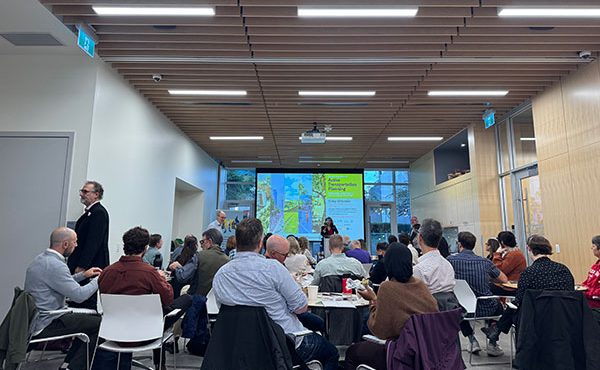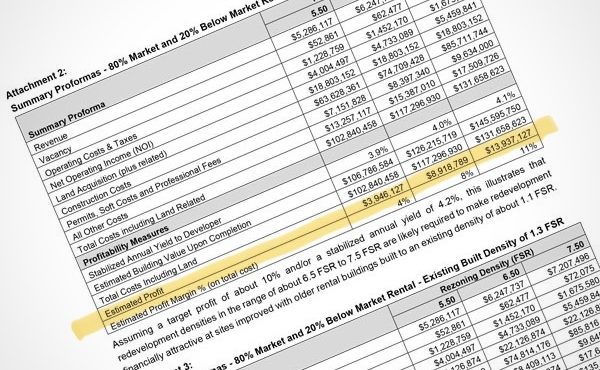Much like Juhani Pallasmaa wowed the crowd at the Vancouver Playhouse over a year ago and David Byrne a few months past, Jan Gehl inspired a capacity house of planners, architects, educators, and cycling advocates on a rainy winter’s night two weeks ago – presenting his vision of incremental change for our burgeoning cities, and heralding a more people-scaled built environment sympathetic to the plight of the modern city dweller.
In this latest installment of UBC School of Architecture and Landscape Architecture’s Arthur Erickson Memorial lecture series, a full house at the Vancouver Playhouse was enthralled to hear Danish architect Jan Gehl bring his world renowned ‘Copehagenizing’ philosophy to Vancouver, with the event also being an opportunity for many to get an autographed copy of his latest book Cities for People (Island Press, 2010). With numerous witty observations interspersing his talk throughout the evening – many times rousing the audience to laughter with his amiable sense of humour – Mr. Gehl comes at an urgent time, when cycling as a mass form of alternate transportation (an astonishing 37% bike to work in Copenhagen) is on everyone’s lips in our city, along with many others around the world.
Introduced by Leslie Van Duzer, Director of SALA at UBC (and herself a speaker in the same lecture series this coming February 22nd), Mr. Gehl was thanked for offering to stay in Vancouver the whole week to take part in a number of other events at UBC and around Metro Vancouver City. She also thanked the evening’s sponsors, Kasian Architecture and Bing Thom Architects, with Michael McDonald from the former getting up to say a few words of introduction.
Pointing out that there is now a city in China whose population is greater than that of Canada’s, McDonald broadly spoke to the issue that there is no escaping the modern auspice of the city – an urban choice and lifestyle which the planet’s developing nations are aspiring to and attaining at an unprecedented pace. With this in mind, the race is on to learn to live better in our cities before we are smothered by a stultifying urban condition from which we cannot escape, and/or exhausting our city-building resources. Speaking of his first trip to Copenhagen, Mr. McDonald enlightened the crowd as to the fantastic incremental change that Jan’s vision has realized there, and which could also be realized here.
Stepping to the stage, Gehl immediately won the crowd with his humility and sense of humour, and proceeded to ‘Copenhagenize’ the room. With a talk entitled ‘Cities for People,’ from his recently published book, he revealed how the framing elements of his latest treatise are in fact two paradigm shifts, which he claims have occurred in the last 50 years. The first paradigm shift in the 1960’s, what he called a ‘car-invasion,’ has more recently been usurped by a second paradigm shift, i.e. the information age. The body of his book is hence composed upon a series of observations depicting what has happened in that time, beginning with his first observations from when he graduated from architecture school.
As he explained it, prior to the 1960’s, cities grew in small increments by adding units that were in keeping with human scale (or as he called it, the ‘good old days’). Following this however, rapid technological advance enabled cities to add to themselves in larger increments. What was once a city built at the human speed of 5 km/hr was usurped by a city moving 60 km/hr. With the advent of the automobile as the new modular unit of the city, traffic engineering emerged as a profession to manage and find room for more and more traffic – making the cars happy instead of the people. Something had been lost in this transaction, Gehl rightly pointed out, with some degree of human dignity being lost in the process.
At the end of October, legendary singer of the Talking Heads David Byrne also spoke at the Vancouver Playhouse, lamenting the hegemony of the automobile in the city which had rendered some corners of many American cities impassable to the cyclist and pedestrian alike. At that time, Byrne showed an image by Swiss architect Le Corbusier and bemoaned these ‘visionary’ architects for unleashing roads upon the world to satisfy the needs of a new automobile dominated future. It is not without some irony that three months later, Gehl spoke on the same stage about the same architect, but as Gehl had not misunderstood the lesson of that great master, he summed it up in one terse statement for all those gathered to hear: that Le Corbusier, in fact, thought that streets were ‘bad.’
Le Corbusier had written about the loss of the ‘people-scale’ to the automobile in the 1920’s. His vision of a city for a three million inhabitants was not a group of residential towers surrounded by roads (which Byrne had mistakenly thought) but by parks and open spaces. The roads were underground running through tunnels, with auto traffic separated from transport trailers and trains. The domain above grade was for the pedestrian, for the cyclist, for plazas and community markets, gardens and playgrounds – those activities that populate the ‘people-scale.’ The American city, as Gehl observes, is a hybrid of Corb’s vision of the “Contemporary City” married to America’s love of the automobile.
Told as a humourous sidebar, Gehl recounted graduating from architecture school in 1960 with lofty modernist ideals, only to be grounded by the poignant observation of a psychologist (who subsequently married him): “Why aren’t you architects concerned with people?” The question prompted Gehl to take a long, hard look at the tenets of modernism, certainly in its love-affair with the automobile. The result was Gehl’s formulation of three scales of plan which typified urban planning post-1960. From large to small, they are: the City Plan, or bird’s eye/airplane view of the city; the Site Plan, or rooftop/helicopter view; and lastly the one-to-one Person Plan, or eye-level view moving at 5 km/hr. Gehl posits that planning and architecture seem to work only exclusively at the first two scales, often at the expense of the third and most important scale.
He recounted how in 1961, Jane Jacobs spoke up in Greenwich Village, standing up to the modern city planner Robert Moses who wanted to tear down Chinatown, Little Italy, Soho, and of course Greenwich Village. Gehl reminded the crowd that she rallied those communities to defy the bulldozers, and the expressways that were to have been never came, saving a number of neighbourhoods in Lower Manhattan in the process (she writes, of course, about all this in her Death and Life of Great American Cities.)
He called the city-scale planning method (from 5000 feet overhead) the ‘Brasila Syndrome’ and illustrated this with images from the city, where large urban vacuums exist between roads and buildings – planning done with a mile high pencil. As such, the city looks great out the window of an airplane, but is inhospitable and punishing at the street level. In one of the most humourous moments of the evening, Gehl described the ‘Brasila Syndrome‘ in Dubai as ‘birdshit architecture’, with a graphic done by one of his students to illustrate the same.
He followed this by pointing out how in the older cities, tradition and experience looked after the ‘people scale’, while modern planning has not followed suit, due to its fixation on the automobile. With a few shots at such contemporaries as Rem Koolhaas, Norman Foster, and Frank Gehry, Gehl pointed out how architects seem more obsessed by form than interested in the ‘people scale’. To Gehl, good architecture is the interaction of life and form, not an obsession with what he calls ‘perfume architecture’. To this he humourously adds that architecture schools should have a course on how to design a good ground floor plan.
He talked about the problem of extra large architecture, a confusion of scale, where buildings are getting bigger and faster while people remain small and slow. It must be the landscape architects then that will surely look after the ‘people-scale’ if the architects cannot. But unfortunately, Gehl believes, they like architects are also form-obsessed. Poking fun at a presentation drawing from Rem Koolhaas’ office, in which an outdoor plaza is almost overflowing with people, he showed the crowd a more recent photo in which the space is bereft of people. In contrast, showing photos of an old district in Copenhagen, built in 1905, he pointed out from the airplane and rooftop scale, the view is rather ordinary, while at the people-scale there is porch with an overhang, with a front stoop, and people living, walking, biking.
At present, he believes this new paradigm of more livable, healthy, and sustainable cities is dependent on the decisions we make now. Cities around the world can learn his lessons from Copenhagen, to begin the incremental change from the motor vehicle to alternate froms of transportation. As such, he pointed out that 37% people in Copenhagen now bike to work (the goal is to get 50%), with 33% using public transit. As a result of this, a significant population of Copenhagen’s citizens people are now spending time in the city centre rather than commute to the suburbs at the end of every day.Such figures are indeed awe inspiring, and a wake up call for our auto-choked cities in North America.
Explaining his 12 point quality criteria for assessing good cities – including such things as comfort, beauty, safety, etc. – he gave examples of bad and good cities, with cities like Siena and Melbourne getting top marks (though the latter he pointed out was an example of a bad city in the 1980s). Finishing his talk, Gehl gave a brief slide show of places in the world where bike lanes are being added, including Sydney, Washington D.C., and New York, showing dramatic images of Times Square before and after the traffic closures there. To finish his talk, he quoted ‘New York New York’ saying that if you can make it there (by bicycle), you can make it anywhere.
Overall, it was a an evening of wit, laughs, and provocative thought. We in Vancouver, no longer have any excuses now that Gehl’s message has reached us first-hand…the next move is ours.
***
Sean Ruthen is a Vancouver-based architect and writer.




